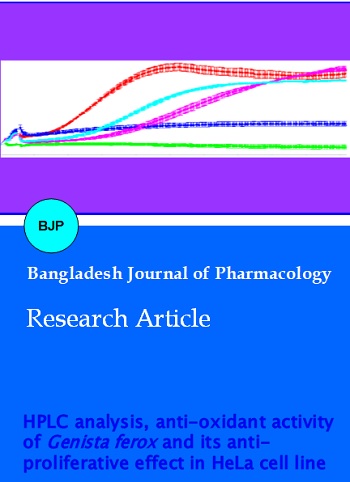HPLC analysis, anti-oxidant activity of Genista ferox and its anti-proliferative effect in HeLa cell line
DOI:
https://doi.org/10.3329/bjp.v12i3.32310Keywords:
Antiproliferative, FolinCiocalteu, Genista ferox, HPLC-TOF/MSAbstract
The prevention and treatment of the cancer using plants have attracted increasing interest. The present study was aimed to determine the phenolic compounds of Genista ferox using HPLC-TOF/MS and the anti-oxidant acti-vity associated with anti-cancer activity against human cervical adenocarcinoma (HeLa) cell line. Total anti-oxidant capacities of different extracts of G. ferox were assessed by DPPH assay, and their total phenolic and flavonoids contents measured by FolinCiocalteu and aluminum trichloride assays. The amounts of total phenolic (105.2 ± 0.6 308.5 ± 5.7 mg/g) of extract measured as gallic acid equivalent and flavonoids (8.1 ± 0.1 124.0 ± 0.7 mg/g) of extract measured as quercetin equivalent varied from chloroform to n-butanol extract of the two parts of the plant (leaf and stem). The ethyl acetate extract of G. ferox exhibited the most powerful effect on the DPPH scavenging activity with 94% from the leaf and 93% from the stem, while the chloroform extract from the leaf exhibited the most effective anti-proliferative activity against HeLa cell lines.
Video Clip of Methodology:
4 min 6 sec Full Screen Alternate
Downloads
50
40 Read
12

Published
How to Cite
Issue
Section
License
Authors who publish with this journal agree to the following terms:
- Authors retain copyright and grant the journal right of first publication with the work simultaneously licensed under a Creative Commons Attribution License that allows others to share the work with an acknowledgement of the work's authorship and initial publication in this journal.
- Authors are able to enter into separate, additional contractual arrangements for the non-exclusive distribution of the journal's published version of the work (e.g., post it to an institutional repository or publish it in a book), with an acknowledgement of its initial publication in this journal.
- Authors are permitted and encouraged to post their work online (e.g., in institutional repositories or on their website) prior to and during the submission process, as it can lead to productive exchanges, as well as earlier and greater citation of published work (See The Effect of Open Access).
